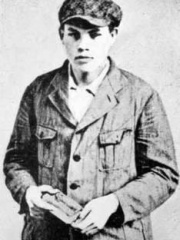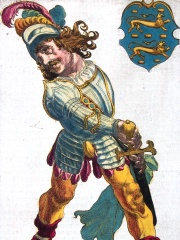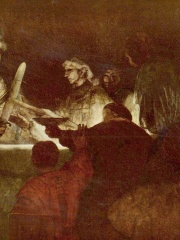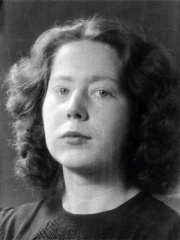




The Most Famous
SOCIAL ACTIVISTS from Netherlands
This page contains a list of the greatest Dutch Social Activists. The pantheon dataset contains 840 Social Activists, 6 of which were born in Netherlands. This makes Netherlands the birth place of the 33rd most number of Social Activists behind Somalia, and North Korea.
Top 6
The following people are considered by Pantheon to be the most legendary Dutch Social Activists of all time. This list of famous Dutch Social Activists is sorted by HPI (Historical Popularity Index), a metric that aggregates information on a biography's online popularity.

1. Marinus van der Lubbe (1909 - 1934)
With an HPI of 69.05, Marinus van der Lubbe is the most famous Dutch Social Activist. His biography has been translated into 33 different languages on wikipedia.
Marinus van der Lubbe (Dutch pronunciation: [maːˈrinʏs fɑn dər ˈlʏbə]; 13 January 1909 – 10 January 1934) was a Dutch communist who was tried, convicted, and executed by the government of Germany for setting fire to the Reichstag building—the national parliament of Germany—on 27 February 1933. During his trial, the prosecution argued that van der Lubbe had acted on behalf of a wider communist conspiracy, while left-wing anti-Nazis argued that the fire was a false flag attack arranged by the Nazis themselves. Most historians agree that van der Lubbe acted alone, although this is occasionally disputed. In 2008, nearly 75 years after the event, the German government granted van der Lubbe a posthumous pardon.

2. Pier Gerlofs Donia (1480 - 1520)
With an HPI of 68.76, Pier Gerlofs Donia is the 2nd most famous Dutch Social Activist. His biography has been translated into 27 different languages.
Pier Gerlofs Donia (c. 1480 – 28 October 1520) was a Frisian farmer, rebel leader, and pirate. He is best known by his West Frisian nickname Grutte Pier ('Big Pier'; in the pre-1980 West Frisian spelling written as Greate Pier), or by the Dutch translation Grote Pier, which referred to his legendary size, strength, and bravery. His life is mostly shrouded in legend. Based upon a description now attributed to Pier's contemporary Petrus Thaborita, the 19th-century Dutch historian Conrad Busken Huet wrote that Grutte Pier was A tower of a fellow as strong as an ox, of dark complexion, broad shouldered, with a long black beard and moustache. A natural rough humorist, who through unfortunate circumstances was recast into an awful brute. Out of personal revenge for the bloody injustice that befell him (in 1515) with the killing of kinsfolk and destruction of his property he became a freedom fighter of legendary standing.

3. Gaius Julius Civilis (25 - 100)
With an HPI of 66.30, Gaius Julius Civilis is the 3rd most famous Dutch Social Activist. His biography has been translated into 27 different languages.
Gaius Julius Civilis (AD 25 – c. 1st century; erroneously also Claudius Civilis) was the leader of the Batavian rebellion against the Romans in 69 AD. His nomen shows that he (or one of his male ancestors) was made a Roman citizen (and thus, the tribe a Roman vassal) by either Augustus or Caligula.

4. Hannie Schaft (1920 - 1945)
With an HPI of 61.71, Hannie Schaft is the 4th most famous Dutch Social Activist. Her biography has been translated into 20 different languages.
Jannetje Johanna (Jo) Schaft (16 September 1920 – 17 April 1945) was a Dutch resistance fighter during World War II. She became known as "the girl with the red hair" (Dutch: het meisje met het rode haar, German: das Mädchen mit dem roten Haar). Her secret name in the resistance movement was "Hannie".

5. Johannes Kleiman (1896 - 1959)
With an HPI of 61.08, Johannes Kleiman is the 5th most famous Dutch Social Activist. His biography has been translated into 15 different languages.
Johannes Kleiman (17 August 1896 – 28 January 1959) was a Dutch resident who helped hide Anne Frank and her family during World War II. In the published version of Frank's diary, Het Achterhuis, known in English as The Diary of a Young Girl, he is given the pseudonym Mr. Koophuis. In some later publications of the diary, the pseudonym was removed (just like the other protectors' pseudonyms), and Kleiman was referred to by his real name. Kleiman was born in Koog aan de Zaan, the Netherlands, and met Otto Frank in 1923, when he was trying to establish a branch of the Michael Frank Bank in Amsterdam. Kleiman was registered as a proxy for the bank in May 1924 and given full powers in December of that year when the bank went into liquidation. He was hired by Frank as a bookkeeper for Opekta and Pectacon in 1938, but had become a close friend from about 1933, when the Frank family fled to the Netherlands to escape Nazi persecution in Germany. Johannes Kleiman became a member of the board of Opekta and the company was established at his home address for the next five months until it moved to Prinsengracht 263 at the end of 1940. He officially joined as bookkeeper for both Opekta and Pectacon, with Victor Kugler and secretary Bep Voskuijl for Pectacon, and Otto Frank and his secretary Miep Gies for Opekta.

6. Tanja Nijmeijer (b. 1978)
With an HPI of 43.74, Tanja Nijmeijer is the 6th most famous Dutch Social Activist. Her biography has been translated into 14 different languages.
Tanja Nijmeijer (Dutch pronunciation: [ˈtɑɲaː ˈnɛimɛiər]; born 13 February 1978), also known as Alexandra Nariño, is a Dutch former guerrilla and English teacher who has been a member of the Colombian guerrilla group Revolutionary Armed Forces of Colombia (FARC) since 2002. She has also been one of the group's leading public figures since the discovery of her diary in 2007. She was part of the negotiating team involved in unsuccessful peace talks with the Colombian government.
People
Pantheon has 6 people classified as Dutch social activists born between 25 and 1978. Of these 6, 1 (16.67%) of them are still alive today. The most famous living Dutch social activists include Tanja Nijmeijer. The most famous deceased Dutch social activists include Marinus van der Lubbe, Pier Gerlofs Donia, and Gaius Julius Civilis. As of April 2024, 1 new Dutch social activists have been added to Pantheon including Tanja Nijmeijer.
Living Dutch Social Activists
Go to all RankingsDeceased Dutch Social Activists
Go to all RankingsMarinus van der Lubbe
1909 - 1934
HPI: 69.05
Pier Gerlofs Donia
1480 - 1520
HPI: 68.76
Gaius Julius Civilis
25 - 100
HPI: 66.30
Hannie Schaft
1920 - 1945
HPI: 61.71
Johannes Kleiman
1896 - 1959
HPI: 61.08
Newly Added Dutch Social Activists (2025)
Go to all RankingsOverlapping Lives
Which Social Activists were alive at the same time? This visualization shows the lifespans of the 3 most globally memorable Social Activists since 1700.

